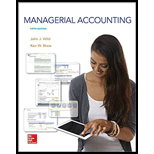
1.
To compute: Annual expected net
1.
Explanation of Solution
Given below is the table for the computation of annual expected net cash flows:
| Particulars | Project A ($) | Project B ($) |
| Net income | 39,900 | 25,900 |
| 60,000 | 80,000 | |
| Net cash flows | 99,900 | 105,900 |
Working note:
Calculation of annual depreciation of Project A,
Calculation of annual depreciation of Project B,
Hence, cash flow after tax is from project A is $99,900 and Project B is $105,900.
2.
To compute: Payback period.
2.
Explanation of Solution
Computation of payback period for project A:
Given,
Cost of investment of Project A is $240,000.
Annual net cash flow from Project A is $99,900.
Formula to calculate payback period,
Substitute $240,000 for initial investment and $99,900 for net annual
Computation of payback period for project B:
Given,
Cost of investment of Project B is $240,000.
Annual net cash flow from Project B is $105,900.
Formula to calculate payback period,
Substitute $240,000 for initial investment and $105,900 for net annual cash inflow.
Hence, payback period of project A is 2.40 years and Project B is 2.27 years.
3.
To compute: Accounting
3.
Explanation of Solution
Computation of accounting rate of return (ARR) for Project A:
Given,
Average annual profit of Project A is $39,900.
Average investment in Project A is $120,000.
Formula to calculate of accounting rate of return,
Substitute $39,900 for average annual profit and $120,000 for average investment.
Computation of accounting rate of return (ARR) for Project B:
Given,
Average annual profit of Project B is $25,900.
Average investment in Project B is $120,000.
Formula to calculate of accounting rate of return,
Substitute $25,900 for average annual profit and $120,000 for average investment.
Working note:
Calculation of average investment of Project A,
Calculation of average investment of Project B,
Hence, ARR for project A is 33.25% and Project B is 21.58%.
4.
To compute:
4.
Explanation of Solution
Computation of Net present value (NPV) for Project A:
Given,
Annual net cash flows from Project A is $199,900.
Cost of investment is $240,000.
Market interest rate is 8%.
Number of periods is 4 years.
Present value factor for cumulative 4 years is 3.3121.
Formula to calculate NPV,
Substitute $330,879 for the present value of cash flows and $240,000 for the cost of investment.
Computation of Net present value (NPV) for Project B:
Given,
Annual net cash flow from Project B is $105,900.
Cost of investment is $240,000.
Market interest rate is 8%.
Number of periods is 3 years.
Present value factor for cumulative 3 years is 2.5771.
Formula to calculate NPV,
Substitute $272,915 for the present value of cash flows and $240,000 for the cost of investment.
Working notes:
Formula to calculate present value of cash flows of Project A,
Formula to calculate present value of cash flows of Project B,
Hence, NPV for project A is $90,879 and Project B is $32,915.
5.
To identify: Recommendation to management to pursue Project A.
5.
Explanation of Solution
Hence, it is recommended to management to pursue Project A.
Want to see more full solutions like this?
Chapter 11 Solutions
MANAGERIAL ACCOUNTING FUND. W/CONNECT
- The ending inventory of Thornton Supplies Inc. is $45,000. If the beginning inventory was $62,000 and goods available for sale totaled $148,000, what is the cost of goods sold?arrow_forwardFinancial Accounting Questionarrow_forwardHii teacher please provide for General accounting question answer do fastarrow_forward
- I need assistance with this general accounting question using appropriate principles.arrow_forwardCompute the amount of underapplid or overaplied overhead cost for the yeararrow_forwardRegency Distributors wants an ending inventory each month equal to 20% of that month's cost of sales. Cost of sales for April is projected at $150,000. Ending inventory at the end of March was $25,000. Based on this information, purchases for April will be: a. $125,000 b. $130,000 c. $145,000 d. $155,000arrow_forward

 AccountingAccountingISBN:9781337272094Author:WARREN, Carl S., Reeve, James M., Duchac, Jonathan E.Publisher:Cengage Learning,
AccountingAccountingISBN:9781337272094Author:WARREN, Carl S., Reeve, James M., Duchac, Jonathan E.Publisher:Cengage Learning, Accounting Information SystemsAccountingISBN:9781337619202Author:Hall, James A.Publisher:Cengage Learning,
Accounting Information SystemsAccountingISBN:9781337619202Author:Hall, James A.Publisher:Cengage Learning, Horngren's Cost Accounting: A Managerial Emphasis...AccountingISBN:9780134475585Author:Srikant M. Datar, Madhav V. RajanPublisher:PEARSON
Horngren's Cost Accounting: A Managerial Emphasis...AccountingISBN:9780134475585Author:Srikant M. Datar, Madhav V. RajanPublisher:PEARSON Intermediate AccountingAccountingISBN:9781259722660Author:J. David Spiceland, Mark W. Nelson, Wayne M ThomasPublisher:McGraw-Hill Education
Intermediate AccountingAccountingISBN:9781259722660Author:J. David Spiceland, Mark W. Nelson, Wayne M ThomasPublisher:McGraw-Hill Education Financial and Managerial AccountingAccountingISBN:9781259726705Author:John J Wild, Ken W. Shaw, Barbara Chiappetta Fundamental Accounting PrinciplesPublisher:McGraw-Hill Education
Financial and Managerial AccountingAccountingISBN:9781259726705Author:John J Wild, Ken W. Shaw, Barbara Chiappetta Fundamental Accounting PrinciplesPublisher:McGraw-Hill Education





